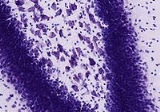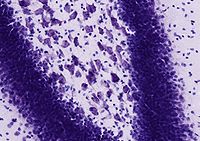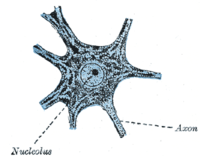
Nissl body
Encyclopedia


Endoplasmic reticulum
The endoplasmic reticulum is an organelle of cells in eukaryotic organisms that forms an interconnected network of tubules, vesicles, and cisternae...
(with free ribosomes) and are the site of protein synthesis. It was named after Franz Nissl
Franz Nissl
Franz Nissl was a German medical researcher. He was a noted neuropathologist.-Early life:...
, German neurologist (1860-1919).
Nissl bodies can be demonstrated by a method of selective staining developed by Nissl (Nissl staining), using an aniline
Aniline
Aniline, phenylamine or aminobenzene is an organic compound with the formula C6H5NH2. Consisting of a phenyl group attached to an amino group, aniline is the prototypical aromatic amine. Being a precursor to many industrial chemicals, its main use is in the manufacture of precursors to polyurethane...
stain to label extranuclear RNA
RNA
Ribonucleic acid , or RNA, is one of the three major macromolecules that are essential for all known forms of life....
granules. This staining method is useful to localize the perikaryon, cell body, as it can be seen in the Soma (biology)
Soma (biology)
The soma , or perikaryon , or cyton, is the bulbous end of a neuron, containing the cell nucleus. The word "soma" comes from the Greek σῶμα, meaning "body"; the soma of a neuron is often called the "cell body"...
and dendrites of neurons, though not in the axon
Axon
An axon is a long, slender projection of a nerve cell, or neuron, that conducts electrical impulses away from the neuron's cell body or soma....
or axon hillock
Axon hillock
The axon hillock is a specialized part of the cell body of a neuron that connects to the axon. As a result, the axon hillock is the last site in the soma where membrane potentials propagated from synaptic inputs are summated before being transmitted to the axon. For many years it was believed...
. Due to RNA's basophilic
Basophilic
Basophilic is a technical term used by histologists. It describes the microscopic appearance of cells and tissues, as seen down the microscope, after a histological section has been stained with a basic dye. The most common such dye is haematoxylin....
(lat. "base-loving") properties it is stained blue by this method.
Nissl bodies show changes under various physiological conditions and in pathological conditions they may dissolve and disappear (karyolysis
Karyolysis
Karyolysis is the complete dissolution of the chromatin matter of a dying cell due to the activity of DNase. The whole cell will eventually stain uniformly with eosin after karyolysis. It is usually preceded by karyorrhexis and occurs mainly as a result of necrosis, while in apoptosis after...
).
They are thought to be involved in the synthesis of neurotransmitters such as acetylcholine
Acetylcholine
The chemical compound acetylcholine is a neurotransmitter in both the peripheral nervous system and central nervous system in many organisms including humans...
.

